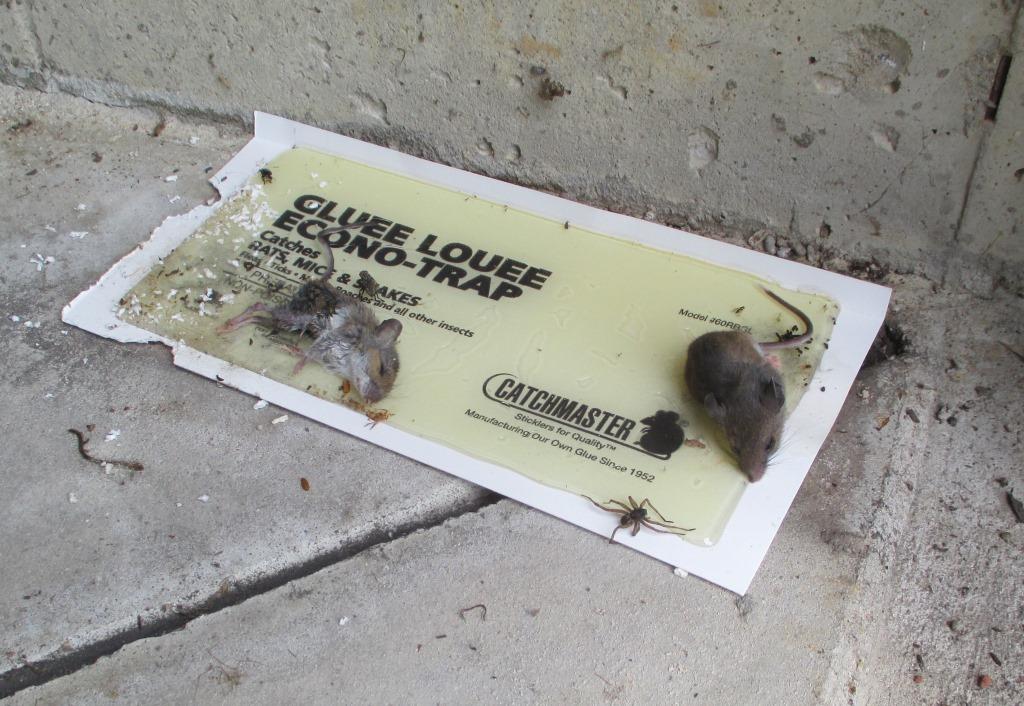Intro and Welcome
Building on the success of the two previous public presentations sessions, in 2024 the MuseumPests Working Group and the UK Pest Odyssey collaborated in presenting nine short presentations on a wide range of cultural heritage IPM topics. The PowerPoint presentations are available below and a recording of the session is available on the MuseumPests YouTube channel.
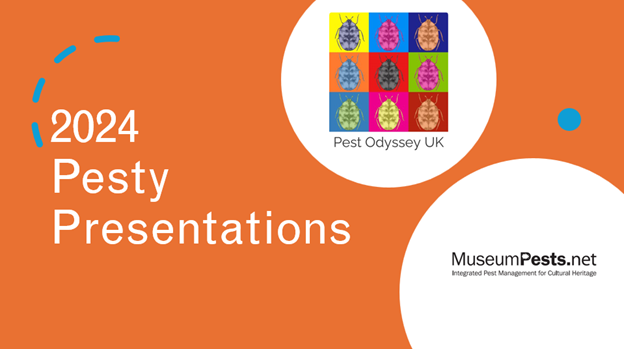
Developing commercially viable nano-biopesticides using herbal plants for sustainable pest management in cultural institutions
Fatma Faheem, India
Within cultural institutions worldwide, the delicate balance between tradition and cutting-edge technology is crucial for effective heritage preservation. This research proposal targets a fundamental challenge encountered across various cultural institutions, focusing on the conservation of organic materials, particularly those derived from animal skins, within valuable collections. Through the development and application of advanced nano-biopesticides, the initiative aims to revolutionize pest management strategies, thereby ensuring the sustainable preservation of artifacts and the enduring legacy of cultural treasures on a global scale. By integrating traditional conservation methods with the innovative potential of nanotechnology, the proposal addresses immediate preservation needs while upholding a commitment to knowledge advancement, global awareness, and the preservation of aesthetic integrity across diverse cultural contexts. This proposal encourages scholarly exploration into the intersection of tradition and technology, with the ultimate goal of safeguarding the cultural heritage enshrined within esteemed collections worldwide.
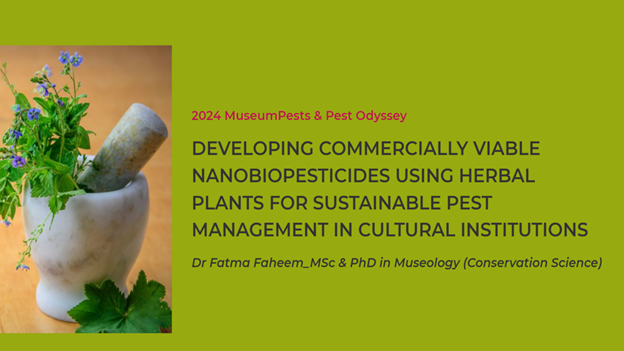
Managing Webbing Clothes Moth, Naturally
David Loughlin, U.K.
This presentation provides an update to the Pest Odyssey 2021 presentation which explained how high numbers of Webbing Clothes Moth (Tineola bisselliella) at the National Trust Blickling Estate have been reduced by an IPM approach based on biological controls and how the program is being further extended to other sites and situations.
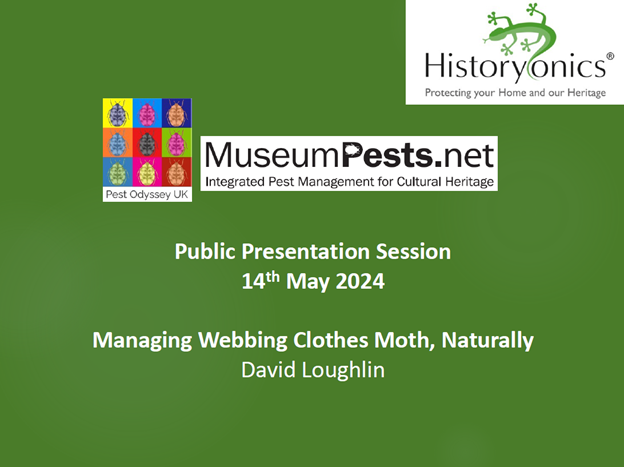
Case Study: A Stegobium Panecium (Biscuit Beetle) infestation in the Museum of London’s library?
Sophie Oelman & Stephanie Richardson-Jones, U.K.
In April 2023 a large number of beetles were found on the windowsills of the Library at the museum’s London Wall site, this was reported to Collections Care. Collections Care investigated and identified the adult beetles as Biscuit Beetle Stegobium Panecium. Inspections, deep cleans and spot checking were carried out and there was no obvious food source. Collections Care suspected the source to be an adjoining office where beetles were found, where colleagues ate and was not regularly cleaned. Beetle numbers dropped slightly but this was likely a result of seasonal change. Other potential sources were investigated. The source of the beetles was discovered during a visit from Chris Swindells from Kiwa Independent Pest Consultancy in November 2023. When Chris examined old rodent bait boxes, he identified the bait used as cereal based, when the box was opened we could see visible biscuit beetle and it was clear this was the source of the infestation. During the examination of the bait boxes suspected parasitic wasps were visible, this suggests that the biscuit beetle population was supporting biological control. The bait boxes were removed and Chris suggested the use of a biscuit beetle pheromone lure that had been tested by the RHS Archive. Following the removal of the bait boxes recorded beetle numbers dropped significantly. We are continuing to monitor using pheromone lures as well as blunder traps. Collections were not damaged as a result of the beetle infestation.

Standard Operation Procedures for Touring Exhibitions: An Opportunity for Collaboration.
Armando Mendez, U.K.
The Natural History Museum, London is working on preparing Standard IPM Operating Procedures for touring exhibitions. Please reach out to Armando if you are interested in collaborating on the development of a document that can be shared by institutions that present touring exhibitions.
What Happens in the Dark: A Massive Moth Infestation Case Study
Fran Ritchie, U.S.
Like many institutions around the world, a visitor center at a U.S. Fish and Wildlife Services site in the eastern U.S. remained closed to visitors and staff for over a year during the heart of the pandemic. During this time, a massive clothing moth infestation broke out in the taxidermy on display, due to taxidermy preparation techniques, poor exhibit design, and no housekeeping or IPM. With no formal museum program, center staff contacted conservators and taxidermists for answers and advice, and a thorough onsite examination was performed of the exhibit space, specimens, and building. Although this story does not have a happy ending, there are many ways that the community can learn from this situation, especially for those who are new to the world of integrated pest management. This case study illustrates what can go wrong when exhibits are left in the dark.
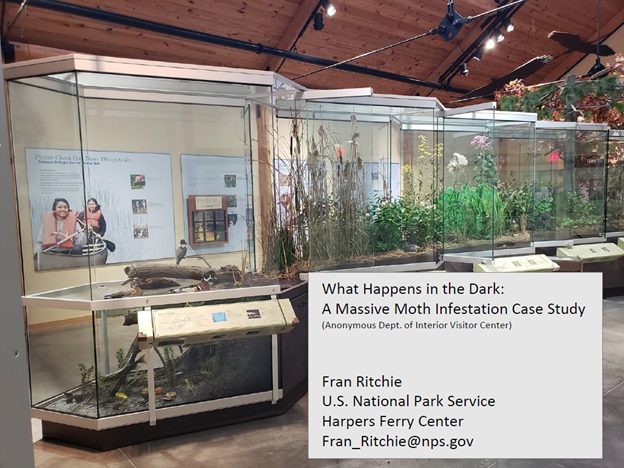
From Cuisine to Collections: The risks from pests that make their way into museums from museum restaurants and staff food supplies
Patrick Kelley, U.S.
Museum cafes and restaurants have become integral components of the visitor experience, offering a chance to rejuvenate amidst exhibits and fostering a sense of community. From a bottom-line standpoint, museum administrators count on the money generated from the food revenue to pay staff and keep the doors open to the public. However, the presence of food in a museum creates an environment conducive to the presence of pests that can pose a threat to munchable artifacts. There is also a culture that exists within many museums where the museum staff can bring food in with them to eat during the day. The day-to-day influx of human food is a common ‘Trojan Horse’ that allows the entry of pests into the museum. The introduction of pests into museum collections is a genuine concern that museums must address. Common culinary pests, such as grain beetles, carpet beetles, silverfish, booklice, mice and cockroaches, can easily hitch a ride on incoming food supplies. Once inside the museum, these pests can find their way to collections, where they pose a significant risk to irreplaceable items.

Teaching IPM in the Intermountain West
Marie Desrochers, U.S.
As Utah Museum Field Services, we are tasked with supporting preservation efforts in collections across the state of Utah. With most institutions having one or fewer paid staff, many museums are volunteer run with limited resources for preservation efforts. With a National Endowment for the Humanities Preservation & Education Grant from 2021-2024, a regular, annual curriculum of preservation training was developed and continues to support collections care throughout the state. In addition to regular workshops and webinars, Field Services collaborated with Utah collections stewards on specific projects of their choosing, one being a major assessment and treatment of an exhibition of hides and furs that had become infested at a rural Museum that did not have an IPM plan implemented. The assessment and treatment of these objects, as well as multiple taxidermied objects, required consultation with a taxidermy conservator as well as a more focused approach to IPM to manage risks of dermestids and mice. This opportunity created a bigger conversation with collections stewards across the state about IPM and health and safety when it comes to pesticide application. Beyond this workshop, the development of a webinar focused on IPM created greater access to local IPM support and training as stewards grow in their ability to manage pest risks in their own collections. This presentation shares this journey over the past two years to create Utah-focused preventive IPM training.

An Odd Problem To Solve: Update on IPM and Thylodrias contractus (odd beetle)
Rebecca Newberry, U.S.
This is an update to “An odd problem to face: Integrated Pest Management and Thylodrias contractus (Odd beetle)” from the 2021 AIC CCN IPM session. The Science Museum has been using IPM methods to treat an Odd beetle infestation dating back to the 1980’s. Odd beetles are unusual dermestid beetles found primarily in cultural heritage collections. Their life cycle is long, with extended dormant periods of up to several years. When standard methods of monitoring, isolation, and freezing affected items failed to prevent small outbreaks, we began mapping occurrences over time. This helps predict outbreaks where we can target pesticide application. This method showed good promise in 2021 and has resulted in a significant reduction in Odd beetle numbers in 2024.
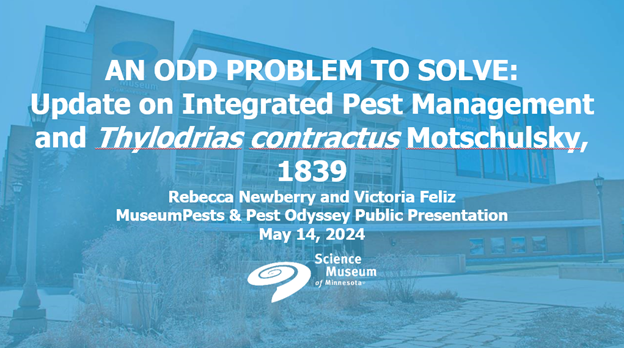
Pending Legislation on Glue/Sticky Traps in the U.K. and U.S.
Chris Swindells, U.K.
Joel Voron and Patrick Kelley, U.S.
Legislation in the U.K. and U.S. designed to prevent the inhumane use of glue traps against rodents may unintentionally impact the use of sticky traps designed for insect monitoring. This presentation will highlight the changing UK legislation and new legislation that has been proposed in New York State.
